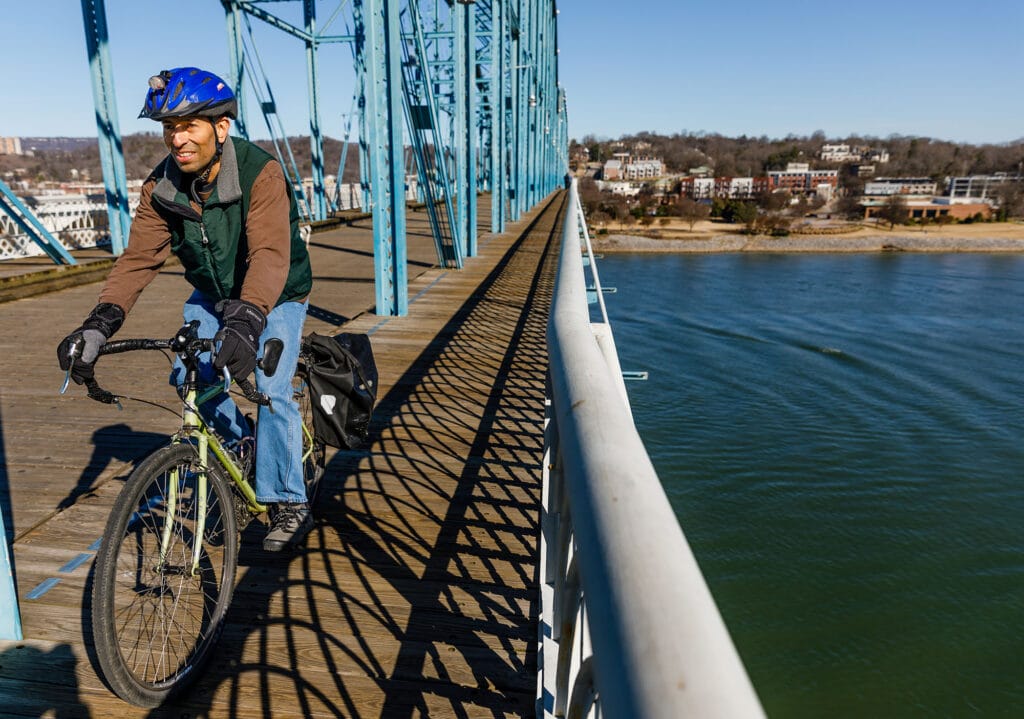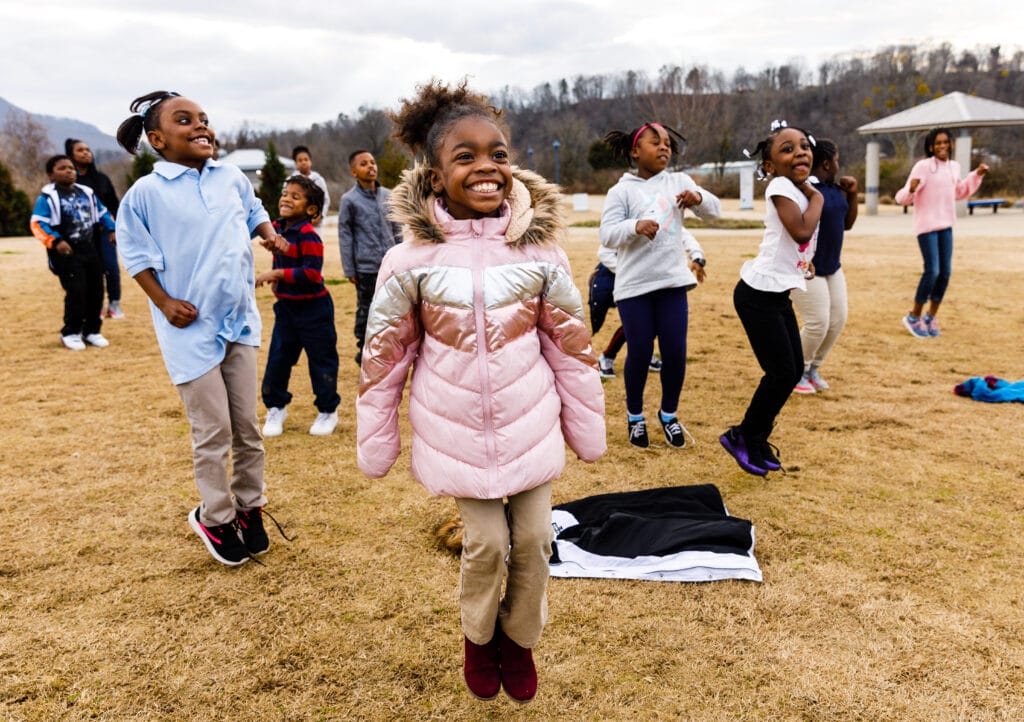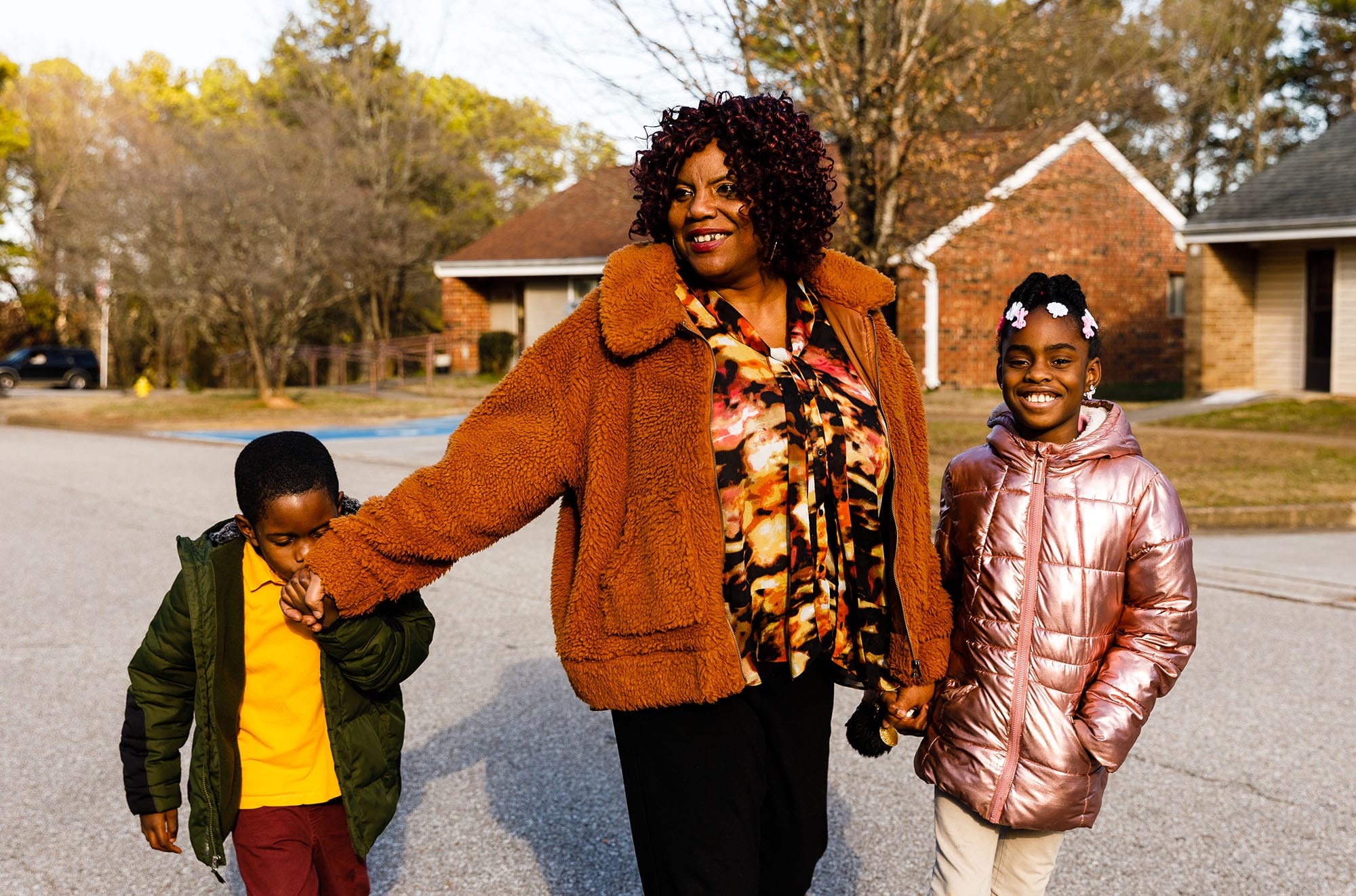Lamyera Holloway has lived in Cromwell Hills, a public housing development in Chattanooga, Tennessee, on and off for 10 years—long enough to remember what it was like before the the South Chickamauga Creek Greenway opened.
“It was very difficult because there was nowhere to really walk,” she recalls. “I didn’t have any place to get exercise or release my stress. It was not a good situation.”
The situation improved in the summer of 2022 with the opening of the South Chickamauga Creek Greenway, a 12-mile multiuse path that connects with Riverwalk, the city’s signature trail that runs along the Tennessee River. Cromwell Hills residents suddenly had a new way to commute to work and, for recreation, could easily access Riverwalk, one of Chattanooga’s main tourist attractions. And between the two paths, cyclists and pedestrians throughout the city have a seamless stretch on which to ride or walk for many miles.
Holloway, a 57-year-old with diabetes, now walks between 2 and 8 miles several times a week. “It’s very therapeutic for me,” she says. “It’s so relaxing—seeing the trees, the river. I go out there and put my headphones in and just get into my own world. I could stay out there all day if I had the chance.”

Cromwell Apartments resident Nelson Barrios rides his bicycle on the Walnut Street Bridge. Photo: Doug Strickland
South Chickamauga Creek originates in a rural area in northwest Georgia, courses its way through the suburbs of Chattanooga, and then runs through a number of communities in the city before emptying into the Tennessee River. One of those communities is Brainerd, where Cromwell Hills was historically hemmed in by a railway, a quarry, and the creek. Bus service in the city is limited, and many residents there don’t have cars. So the ability to move around for work and play was severely constrained.
Donate today to support our work bringing innovative, healthy, green public spaces to people in Tennessee.
The South Chickamauga Creek Greenway, which is accessible to 30,000 people within 1 mile, was long in the making. It began 30 years ago when Trust for Public Land signed a contract with the City of Chattanooga to create and implement a master plan for new green spaces. “We bring the knowledge of a national conservation organization to support the city’s goals for parks, trails, and open space,” says Noel Durant, TPL’s state director in Tennessee.
“That might be GIS support to understand where parks are needed most, community engagement support, or real estate expertise to acquire public access,” he adds. “It’s been a wonderful partnership.”
Trust for Public Land helped secure access to some of the property along the 14-mile Riverwalk, a project with multiple partners. But for the South Chickamauga Creek Greenway, TPL worked single-handedly to acquire strips of land and easements. The work spanned six mayoral administrations and involved negotiations with dozens of property owners. Fortunately, a number of large corporations bordering the greenway, including a Coca Cola bottling plant, donated easements to the project, giving the public the right to access a portion of their land.
But there were tricky obstacles to overcome. “You always run into hurdles along the way,” Durant explains. “We had to build a 200-foot bridge over the creek because we couldn’t secure access in one area.”
After years of progress, there remained what Durant called the “missing middle”—a 4-mile gap that included Cromwell Hills amid the 12 miles of greenway. That portion presented the greatest challenges in terms of construction, with steep terrain, railway bridges, and sewer lines. Trust for Public Land negotiated with five different landowners along the final segment to secure public access, from the CSX Corporation to the Tennessee Valley Railroad Museum.

Children play Simon Says during a trip by the Net Resource Foundation’s after-school program to the Tennessee River Walk’s Blue Goose Hollow trailhead. Photo: Doug Strickland
In June 2022, a ribbon-cutting celebration on a former dairy farm turned trailhead park near the northern terminus of the South Chickamauga Greenway marked the trail’s completion. (TPL the farm, protecting it from development and supporting the re-envisioning of the farm into natural park space.) “That was farther away from the ‘missing middle,’ but it was the best spot along the greenway to acknowledge that ‘Hey, this thing is done,’” Durant says.
While every neighborhood touched by the greenway embraced its completion, Cromwell Hills was perhaps the most impacted. “Cromwell Hills is a forested property and very scenic,” Durant explains. “But the challenge is: How do you get in and out? There are roads, but many residents are transit-dependent. Buses don’t run on weekends or after 7 p.m. on weekdays, so if you don’t have a car, it’s hard to leave. The greenway is viable transportation alternative.”
Cyclists, runners, and walkers of all abilities are gravitating to the South Chickamauga Greenway. Jacobo Salazar Jr., owner of Tiny Bikes in Chattanooga, says the greenway, with its elevated stretches and handsome boardwalks, has opened up new possibilities. “For people looking to get out of the city into more natural areas, it’s a very good route,” he says. “It’s also great if you want to clock more miles.”
Another greenway project TPL is undertaking in Chattanooga centers on Alton Park, a predominantly African American neighborhood only a mile from Riverwalk, and showcases a new approach of a neighborhood-centric greenway. Few residents there visit the walkway, however, because the neighborhood is separated from the walkway and from the rest of the city by a 1.3-mile defunct heavy rail line. Converting that unused rail corridor into a connector trail could potentially link Alton Park to more than 25 miles of trails, including Riverwalk.
“We want to have a high-quality linear park that ties Alton Park into the rest of the city. The community wants this to be as inspiring as the Riverwalk, and so do we.”
– Noel Durant, TPL Tennessee state director
Trust for Public Land is working with the city on a long-term project, known as the Alton Park Connector, that would involve cleaning up the brownfield that surrounds the railway and creating a new trail, with landscaping and lighting. The Alton Park Connector is the first phase of a South Chattanooga trail linking the neighborhoods of Clifton Hills and East Lake to the Tennessee River.
“We want to have a high-quality linear park that ties Alton Park into the rest of the city,” Durant says. “The community wants this to be as inspiring as the Riverwalk, and so do we.”
Lisa W. Foderaro is a senior writer and researcher for Trust for Public Land. Previously, she was a reporter for the New York Times, where she covered parks and the environment.
One-third of Americans, including 28 million children, lack safe, easy access to a park within a 10-minute walk of home. Urge your senators to pass the Outdoors for All Act to create parks and enhance outdoor recreational opportunities!

Donate to become a member, and you’ll receive a subscription to Land&People magazine, our biannual publication featuring exclusive, inspiring stories about our work connecting everyone to the outdoors.

